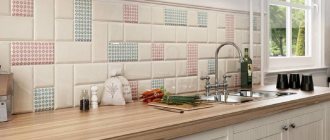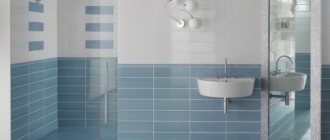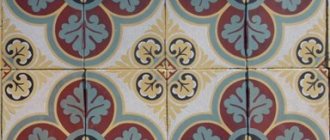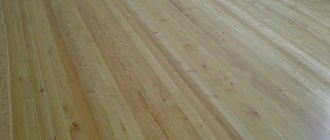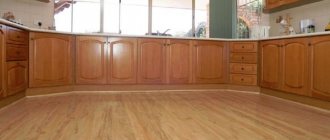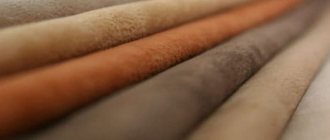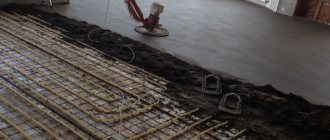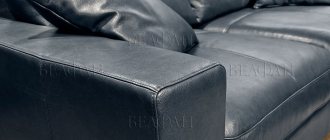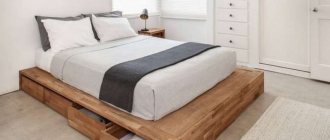An alternative to expensive parquet is vinyl flooring. The unusual coating combines linoleum and wood. The versatility of the material has become an excellent decoration that designers began to use in their projects.
The main advantage of vinyl flooring is its affordable price due to ease of production. The technology is based on thermal pressing of the following components: polyvinyl chloride, quartz chips, fillers, etc. The created material is safe, although the included components are not all natural.
Vinyl flooring contains several layers:
The main bottom layer is made of durable polyvinyl chloride.
The 2nd layer is fiberglass, it is a reinforcing element that protects the coating from various deformations. PVC liner (a mixture of quartz and sand) for durability.
Film for decoration with imitation of different textures of natural materials: leather, wood or stone.
The last layer is a transparent polyurethane film. It protects the product from moisture, as well as various mechanical damage and ultraviolet rays. This layer can be embossed, which means it won’t slip.
Structure - main layers, their composition and purpose
PVC tiles consist of the following layers:
- The outer (front) protective layer is transparent polyurethane hardened by ultraviolet irradiation.
- Decorative layer - a pattern on a polymer film.
- The main layers are PVC with mineral (quartz) chips.
- Fiberglass - used in high-quality expensive composites. Prevents temperature deformation of the product.
- The final layer is made of PVC or adhesive compound. Depending on what material is in the base, different installation methods are practiced.
One of the most common laminate tile structures
Important! Budget brands of vinyl tiles can have only three layers: external protective, decorative and base. As a rule, such products are less strong and durable. There are also monolithic PVC tiles (usually modular), which are used mainly for cladding technical rooms.
Modular monolithic PVC tiles with relief - flooring in the garage
The thickness of multilayer tiles, depending on the brand, can vary between 1.5-3.5 mm. Monolithic, as a rule, has special stiffening ribs that increase the thickness of the product, but at the same time reduce the volume of raw materials used.
Advantages of vinyl tiles
Polyvinyl chloride (PVC) is a thermoplastic synthetic material. Depending on the polymerization conditions, products of varying degrees of polymerization with different physicochemical properties are formed. It is strong enough and has good dielectric properties. Insoluble in water, resistant to acids, alkalis, alcohols, mineral oils. Resistant to oxidation and practically non-flammable
Waterproof - the main advantage is 100% resistance to moisture. The tiles can be laid on the balcony, in the bathroom, toilet, kitchen. There is no material in the composition that can deteriorate if exposed to water. Vinyl borrowed this characteristic from linoleum. Even moisture-resistant laminate cannot compete with vinyl in this parameter. There can be water on the surface around the clock, after drying there will be no traces left.
Silent - textured bottom layer is designed to absorb vibration and shock. Everyone knows how laminate “rings”, vinyl does not have this effect, all your steps and actions are practically silent.
32,33, 43 class - the highest class of wear resistance, achieved by adding PVC chips or quartz sand from the name, Quartz-vinyl tiles are obtained - this is an improved vinyl tile that has extraordinary strength. No other flooring material can yet boast such data.
Design - the design of vinyl tiles can be seen in almost any design. Expensive wood, marble tiles, ceramic tiles, fabric or textiles, stone. This gives you new tools and ideas for creating a unique look for your apartment or house.
Design - 3 types of installation options exist at the moment, self-adhesive, locking, adhesive, more about this below. Precise manufacturing geometry makes installation simple and predictable. The material can be laid in hard-to-reach places, as well as in places with irregular geometry. Installation can be done on floors and walls.
Ecology - all materials are safe for health and do not evaporate any harmful substances; installation can be done in living rooms without harm to health.
Fire safety - the composition of vinyl tiles does not burn, but only melts under the influence of high temperature, which is obtained in the process of open fire.
Format
The most common formats of PVC tiles are:
- square – side size varies from 30 to 60 cm;
- in the form of a board under laminate - there are standardized sizes 10x92, 18x92, 30x60 cm;
- modular - has a square shape, and locking connections are formed along the edges;
- hexagonal and triangular - as a rule, these are high quality products used in residential premises. With their help, you can create a floor covering with an original design.
The process of laying modular PVC tiles
Dimensions of triangular tiles and how to use them in the interior
Variety of PVC tile designs
The variety of textures and colors of plastic panels amazes and pleases at the same time. You can find any colors from a matte purple finish to a discreet stone decor. The most popular colors of panels are decor depicting brick, stone and wood of various shades.
Products made from polyvinyl chloride are highly resistant to various types of alkalis, mineral oils, and solvents.
Where is it used?
The scope of application of PVC tiles is quite diverse. As a rule, these are rooms whose floors are subject to intense mechanical stress of various types: pressure, abrasion, impact deformation, combined with high humidity and other pollution factors. The use of LVT coating depends on its class.
- Class 23-31. (up to 2 mm) Average performance, small thickness of the outer coating up to 0.3 mm, which gives mediocre resistance to mechanical stress. As a rule, it is used in residential premises of medium intensity use: hallway, kitchen, glazed loggia, and for outdoor use - open balconies, verandas, terraces. Service life is about 5-6 years.
PVC tiles in laminate format in the living room
- Class 32-41. (2-2.5 mm) The front covering has an average thickness of 0.3-0.5 mm. The tiles are suitable for installation in rooms with average human traffic: office, retail and commercial premises. Most manufacturers position the service life of commercial PVC coatings at least 15 years.
PVC covering in the office
- Class 43 + special parameters. The tile has a maximum thickness of the outer coating, more than 0.5 mm, or it is monolithic. Used in rooms with maximum or special loads: gyms, medical or educational institutions (special requirements for environmental cleanliness), factory floors, laboratories, chemical, food and pharmaceutical industries.
Vinyl tiles in school lobby
PVC TILES IN THE INTERIOR
Living room
In the main room, the covering should be spectacular and luxurious.
Traffic in the living room is average, so wear resistance class 32-41 will be sufficient.
If you have a large living room (more than 25 m2) with wide windows, choose PVC coating with a semi-matte sheen that imitates stone tiles.
Using complex ornamental figures, you can emphasize the stylistic features of the room and its spaciousness.
However, PVC wood-look planks will also look good, especially in rustic, Nordic and hygge style rooms. For such planks, rooms that are not overloaded with furniture and household items are suitable.
Kitchen
PVC tiles are the right option for the kitchen because they are the only flooring that is 100% waterproof.
In addition to water, the main source of inconvenience in the kitchen is small particles of food after cooking, so the main thing when installing in the kitchen is to choose tiles without a chamfer and with a simple but airtight technology for joining.
PVC coverings of classes 23-32 with a protective layer thickness of at least 0.5 mm are laid in kitchens.
The preferred types of designs for the kitchen are stone or monochromatic abstraction. The abundance of color tints, of course, will make dirt particles invisible, but it will also be more difficult to detect them during cleaning.
Bathroom
The only flooring suitable for the bathroom, other than ceramic tiles, is PVC.
With proper preparation of the base and sealed installation, PVC tiles will serve in the bathroom for a long time.
As a rule, for the bathroom they choose a PVC coating similar to ceramic tiles - plain and light. Tiles with an abstract, uniform pattern are also suitable.
For a bathroom, tiles with small dimensions (no more than 1 m3) of class 33 and with a protective layer of at least 0.5 mm are suitable.
Children's
When choosing PVC tiles for a children's room, make sure that they have high slip resistance - R11 or higher, and also that they have antibacterial treatment.
The manufacturer Decoria positions its tiles as antibacterial.
They use Nano-Silver technology, which involves adding silver ions to polyvinyl chloride.
The strong bactericidal properties of this metal eliminate microorganisms from the coating. Therefore, the child will be able to crawl and walk barefoot with pleasure.
The loads in a children's room are low, so tiles with a wear resistance class of 22-31 will be sufficient.
For children, expressive and whimsical abstract patterns are selected, which a child can stare at for hours, developing his imagination.
Bedroom
The most peaceful room in the house with minimal stress. For a bedroom, a coating of wear resistance class 31 and a small thickness of about 3 mm is sufficient.
It is advisable to choose PVC tiles with a dense soundproof bottom layer so that the sounds of your neighbors do not invade your auditory space.
In the bedroom, both PVC coating with an abstract pattern and a wood one are installed. The stone pattern, according to the staff of Empire of the Floor, is somewhat cold and distant for such a cozy room as a bedroom.
Corridor and hallway
The premises require varied and intense loads, and therefore require high wear resistance of tiles of at least 33-42 classes.
In the corridor or hallway, tiles of dark colors are laid, usually with a stone or wood pattern without complex patterns.
The tiles should be easy to clean, so coatings with durable polyurethane varnish are suitable.
Types of PVC coating according to installation method
In addition to classification by degree of load, PVC tiles are distinguished by installation method.
- Glue. This type of flooring comes in any class. The back surface is rough to improve adhesion; chamfers can be selected along the edges of the front side. Installation is carried out using special glue or mastic.
The best quality fastenings, according to experts, are provided by the following adhesive mixtures:
- Thomsit UK 400;
- Thomsit K188E;
- Deco Bond SSANGKOM;
- Homakoll 208.
The disadvantage of this coating is the need for careful preparation of the base.
Adhesive for laying PVC flooring
- Self-adhesive. Available in both square and laminate formats. An adhesive layer is applied to the lower part, which is protected by a polymer film. The base can be any non-deformable and non-absorbent surface: plywood, chipboard, OSB, cement-sand screed, tiled flooring, etc.
Among the advantages of such tiles, it is necessary to note quick and convenient installation. However, according to most experts, such a coating requires ideal surface preparation, and is also quite sensitive to external influences. In particular, it has a narrow range of temperature and humidity operating conditions, and if they are systematically violated, the tiles may peel off from the base.
Self-adhesive PVC laminate coating
- Glueless. Laying without the use of adhesive agents is typical for large-format thick-layer or monolithic quartz-vinyl tiles.
Installation can be carried out in several ways:
- using a click connection similar to laminate;
- using “puzzle” type end locking connections;
- joint to joint - without the use of locks.
According to the manufacturers, such elements are held together and on the base due to the geometric stability of their shape, as well as the spongy structure of the lower layer. The thickness of such products ranges from 4.5-7 mm. Due to the large thickness, certain defects in the base surface are allowed, which increases wear resistance and service life. The installation itself is very quick and does not require knowledge or any skills. However, such products are the most expensive on the PVC flooring market.
Industrial PVC tiles for glueless installation with hidden locking joints
↑ Guide to laying self-adhesive tiles
After completing the preparatory work and choosing the laying direction, you can proceed to the main thing. Laying PVC tiles begins from the center of the room. It is easy to accurately determine it - you should mark the center of each of the 4 walls and, using a marking cord, connect the dots and draw 2 lines intersecting at an angle of 90 degrees.
Self-adhesive PVC tiles are easy and quick to install
Installation begins along a long wall or along a line of light. There are directional arrows on the reverse side of the PVC strips. When laying, make sure that they are directed in one direction. Apply a thin layer of adhesive to the screed using a notched trowel. Consumption will depend on both the evenness of the floor and the degree of its smoothness.
It is important! Treating the base with a deep penetration primer will help reduce glue consumption.
After the glue gains viscosity (read about this on the packaging), begin carefully gluing the tiles in exact accordance with the preliminary layout. Make sure that no debris gets on the glue, otherwise the tile will not stick well. Roll the roller over the laid tiles. This will help remove excess glue. If glue gets on the face of the tile, immediately remove the stain with a damp sponge. Lay all the prepared material in the same way. The floor is protected from walking and mechanical impacts for 48 hours.
The result of painstaking work
Finishing work has been completed. The tiles are laid - you can admire the fruits of painstaking labor. It is easy to care for this coating. To maintain pristine beauty, it is enough to wipe the floors with soapy water; if stains occur, it is allowed to use alcohol-containing compounds. If scratches appear while moving furniture, rub the damaged areas with wax mastic and small imperfections will become completely invisible.
Main characteristics - operational advantages and disadvantages
- Environmental friendliness. Despite the fact that most manufacturers position their products as environmentally friendly, biologically inert and hypoallergenic material, some brands are not recommended for use in residential areas. As a rule, the labeling of products indicates their area of application. For housing, it is better to use only multilayer tiles with an outer polyurethane layer.
- Water resistance. Polyvinyl chloride does not absorb water, however, for rooms with high humidity (kitchens, bathrooms, washrooms), it is recommended to use products with laminate-type locking joints, which provide additional tightness.
The moisture resistance of PVC tile flooring ranges from waterproof to completely sealed
- Anti-slip effect. The front surface of the product can be either smooth or with a relief, which significantly increases slip resistance. If in tiles used for technical premises such a relief has a purely utilitarian appearance, then for materials used in an office or home, the relief is part of the decorative embossing or texture of the pattern.
Relief embossing on a wood-imitating surface
- Impact resistance and wear resistance. Regardless of the class, the material can withstand significant mechanical stress, leading to damage to almost all other types of floor coverings (except for polymer poured and some types of especially durable concrete floors). The main parameter characterizing high performance indicators is impact strength.
- Thermal stability. The operating temperature range at which the material does not deform for ordinary household PVC tiles is -200C...+300C. Monolithic products can also be used outdoors. However, it should be remembered that at temperatures below -300C they become brittle and cannot withstand the calculated mechanical loads.
The device shows the high thermal inertness of PVC flooring
- Fire hazard. Quartz-vinyl tiles belong to fire resistance class B1 - they do not support combustion;
- Hygienic and easy to clean. PVC coating can be used both in children's and medical institutions. Sanitary-epidemiological and hygienic conclusion No. 026231. For cleaning, it is recommended to use neutral detergents or special vinyl care products.
- Antistatic. The material does not conduct electricity and does not accumulate static, this prevents the accumulation of dust and greatly facilitates cleaning.
- Chemical resistance. Depends on the production method and structure. Multilayer PVC tiles with an outer polyurethane layer are the most chemically resistant. Monolithic grades may be exposed to certain chemicals and solvents such as kerosene, gasoline, etc.
- Soundproofing. PVC coating does not produce sounds when used like a wooden plank floor or parquet; in addition, it muffles acoustic sounds and prevents the spread of shock and vibration noise.
CHARACTERISTICS
Wear resistance classes
Depending on the type of room, service life and thickness, wear resistance classes are distinguished. This is the main indicator by which you should choose tiles.
The indicator consists of two numbers: the first is the type of room, the second is the degree of load.
The first numbers 2 and 3 (of which two are practically no longer used) indicate that the coating is intended for residential and semi-commercial premises, 4 - for commercial and industrial premises.
The second numbers 1, 2, 3 or 4 indicate the degree of load: from light to maximum.
So the marking “33” means that this coating is intended for residential premises with high loads.
Typically, the technical description indicates several rows of numbers, for example 23-33-42, which means: the coating will withstand high loads in everyday life and medium loads in commercial use.
Abrasion
An indicator of how much coating particles are removed under regular loads.
An abrasive disc is used to check. The number of revolutions that the coating can withstand determines its degree of abrasion. If, after passing 25,000 revolutions, less than 0.08 mm is erased from the coating, it is assigned class “T”, which classifies it as non-abrading. Class “P” - if the coating thins by 0.15 mm - slightly abraded, etc. The most abraded class is “F”.
As a rule, most PVC tiles are classified as “T” due to the density of the molecular structure of polyvinyl chloride reinforced with polyurethane.
Water resistance
In our opinion, one of the most important properties of vinyl flooring is water resistance or water resistance. It is precisely in this parameter that PVC tiles leave both linoleum and laminate far behind.
Thanks to the dense molecular structure and the hermetically sealed joint of the PVC strips, the tiles are 100% waterproof on both the impact side and the base side.
This makes PVC coating more attractive than laminate or linoleum. Laminate is based on compressed wood materials, so it still absorbs moisture (Pergo managed to bring its water resistance to 93%, this, of course, is not 100%, but it’s close). Linoleum on the inside usually has a porous structure, so it absorbs moisture from the base.
PVC tiles are free from all these disadvantages.
Thermal conductivity
PVC tiles do not have a porous structure, so their surface heats up quickly and is always slightly higher than the general temperature in the room.
Due to their dense structure, the tiles also do not allow cold from the base to enter the room. Thus, PVC tiles protect against cold on both sides.
Elasticity
The property of tiles to return to their original shape after deformation.
The dense polyvinyl chloride base changes shape only during loads. When the loads disappear, the shape is restored. Elasticity can be measured by residual indentation - how much the shape of the tile has changed after loading.
We, the employees of Empire of Floor, set up an experiment: we pressed the Moduleo tiles from IVC with our nails and saw how it would affect it. After a couple of minutes, the nail mark softened, becoming a small depression. When we checked it a day later, we could no longer distinguish it on the surface.
Slip resistance
The indicator is marked “R”.
Slip resistance is measured by checking at what angle of the surface a person can safely move. To do this, the tester walks along a platform whose inclination angle changes. R9 – minimum value, indicates an angle of 6-10o.
Most PVC tiles (including Pergo) have a slip resistance rating of R10, which indicates an angle of 10-19 degrees.
Sound absorption
The density of the structure and the multi-layer nature of PVC tiles make this coating effectively absorb sound.
Sound is absorbed not only from the base (so you don’t hear your neighbors), but also noise coming from the room. This is facilitated by a polyurethane protective layer.
On average, PVC tiles absorb noise by 15-19 dB. This means that there will be no echo in the room, the voice will be heard clearly, and the high frequencies will be muffled.
UV resistance
After applying the polyurethane layer, PVC tiles are exposed to UV rays, due to which it becomes less photosensitive, does not fade and is strengthened. You can compare this treatment with firing clay pots: so that they cease to be fragile and acquire color stability, they are subjected to a thermal effect.
For example, LVT tiles from Fine Floor are treated with UV rays.
Environmental friendliness
Polyvinyl chloride itself is not a volatile substance, but plasticizers and additives can be added to it, penetrating into the human body, causing a negative effect.
For example, phthalates are widespread in the production of PVC materials. They are needed to ensure PVC elasticity. But biochemical studies have shown that an excessive dose of phthalates in the body negatively affects reproductive function. Following widespread dissemination of this information, manufacturers began to either reduce the amount of phthalates in their products or eliminate them from the production process. The Pergo company, for example, in its catalogs emphasizes that their LVT tiles are 100% phthalate-free. In addition, thanks to the use of recycled materials in Pergo's factories, phthalates cannot enter the tiles.
And Moduleo tiles contain up to 50% recycled material that can be recycled again. Unfortunately, manufacturers do not write what exactly can be recycled.
Another substance whose presence has a carcinogenic effect is formaldehyde. It is widely used due to its strong plasticizing and antiseptic properties. The substance is included in the list of carcinogenic substances, but continues to be used in small doses in the production of household materials, including PVC tiles.
In the technical description of vinyl there is a marking “formaldehyde emission group”, indicating how much of the substance is released into the environment.
Since 2006, flooring manufacturers have been required to ensure that formaldehyde emissions do not exceed ≤0.124 mg/m3 into the air. This corresponds to class "E1". You can pay attention to the technical descriptions of most manufacturers of PVC tiles - the class “E1” is indicated everywhere there.
Laying systems
Since PVC tiles combine the properties of laminate and linoleum, they have great installation possibilities.
The application of a specific installation technology for PVC mainly depends on the thickness of the coating and its elasticity. It is difficult to install a lock into thin and overly elastic tiles, and large and massive tiles are inconvenient to glue due to the impossibility of movement.
Lock connections
The lock is mounted on tiles with a thickness of 3.5 mm - it is difficult to install a lock on a smaller thickness - it requires precise cutting tools that do not incur costs.
Most manufacturers use either a tongue-and-groove system, the so-called Lock lock (when a corresponding tenon is inserted into a slightly concave recess), or a Click system, when the tongue-and-groove lock is equipped with a plastic tag that allows for tighter latching.
The name of the technologies may vary from brand to brand, but essentially they are not much different. However, the manufacturer Pergo uses the original patented PerfectFoldtm technology, which allows you to lay vinyl planks horizontally, vertically, and at an angle. This is possible thanks to a multi-stage locking device: PerfectFoldtm; V is not just a “tenon and groove”, but several levels of fastening with a plastic tongue in the middle.
Adhesive
Classic technology for laying floor coverings. The back side of the tile has a slightly rough surface, which is covered with an adhesive solution or mastic and pressed against a previously leveled and cleaned base.
Manufacturers, as a rule, produce adhesives accompanying coatings that provide the best adhesion of the tiles to the base.
Self-adhesive tiles also belong to the adhesive technology - the back side is covered with a protective film, which is removed as the tile is applied to the base. For the technology to work effectively, the base must be perfectly level and primed.
Glueless
Technology for laying free-lying tiles that have neither a lock nor an adhesive surface. Glueless tiles usually have a significant thickness so that under the influence of their own weight they settle tightly onto the base. In addition, such tiles require stability of geometric shapes and the absence of differences in thickness levels.
Criterias of choice
It is recommended to select PVC tiles according to the following criteria:
- strength (class 23-43);
- wear resistance (T, P, M, F);
- design;
- format.
To determine the values of the parameters, it is necessary to analyze the intensity of use of the room. Most manufacturers, in addition to numerical indicators of product strength, provide more detailed explanations designed for non-professionals. For example, for domestic use, semi-commercial, underfloor heating, etc.
A wide selection of colors and textures of PVC tiles, combined with the exact geometric dimensions of various batches, allows you to create a unique flooring design
As for the tile format, it all depends on the features of the room where the flooring needs to be installed:
- for small rooms it is advisable to use small square or rectangular tiles, this visually increases the area;
- When covering corridors and long rooms with PVC coating in the form of laminate, the elements should be oriented across the room or at an angle.
DESIGNS
Combining the features of linoleum, laminate and ceramic tiles, PVC coatings are produced with matching wood, stone or abstract patterns.
Designs are developed on a computer, taking into account the shape of the coating and installation technology. To develop a pattern, say, for a batch of PVC coating in the form of planks with a wood pattern, requires analysis and processing of several thousand photographs of wood, which are then segmented according to the size of the planks, taking into account the chamfers or lack thereof.
For example, the Moduleo brand develops its complex designs (and they also use imitation of 3-D cubes from rhombuses) using computer programs based on CAD/CAM. This software allows you to create models and assemblies of flooring, view it from different angles and prepare it for production.
Wood imitation
It is used primarily for coatings that imitate laminate (which in turn imitates parquet). Vinyl, depicting a cut of wood, is usually produced in the form of elongated strips from 1.4 to 2 meters long.
The most common tree species depicted on vinyl surfaces are oak, walnut, marble, pine and ash.
Due to the fact that PVC tiles allow the use of embossing technology, PVC planks look voluminous and convincing. From the outside it is impossible to distinguish PVC tiles from laminate.
Imitation stone
Used for coverings in the form of tiles or triangular shapes.
PVC tiles that imitate stone are usually laid in rooms that do not require emphasizing the individuality of the owner - in bathrooms or corridors. In addition, complex stone ornaments look impressive in large living rooms with voluminous ceilings and plenty of light.
Most often, the surface reproduces the image of concrete, slate, travertine. Rare rocks and minerals are also found on the surface of the tiles - for example, mica or quartz.
The manufacturer Forbo, for example, in the Allura Stone collection uses a wide variety of mineral patterns with a clear relief effect. According to the manufacturer, this combination should “emphasize the functionality of the space.”
Also, in order not to create a separate collection, Forbo has tiles with steel and metal patterns in the Allura Stone collection.
Abstraction
This type of image is suitable for progressive people who take into account the functionality of the room and believe that the main thing in an object is purity of form and functionality.
They specialize in the production of PVC coverings with abstract Tarkett designs. Their designers are well versed in the fine arts of the 20th century and perfectly recreate both the cubist forms of Malevich or Klee, and the specifically arranged color masses of Rothko and Pollock.
The use of abstraction is convenient for organizing complex patterns in the form of 3D cubes or diamond-shaped formations.
Features of laying tiles
Laying PVC tiles is a much less labor-intensive process than installing most floor coverings. However, it also requires careful preparation of the surface, as well as special care when installing starting rows. Depending on the type, there are three main technologies for laying vinyl flooring.
Various design options for laying PVC coating, arrangement of elements and appearance in the interior:
Tools used
Most of the tools that may be needed when laying PVC tiles are at the disposal of any self-respecting home craftsman. No specialized or expensive devices are required. This is another advantage of PVC coating. For ease of use, some tools are undergoing slight modernization:
- metal one- or one-and-a-half meter level, ruler or rule. Used for support when cutting. To prevent the metal tool from sliding on the surface of the tile, double-sided tape is glued to its back side and lightly sprinkled with talc, plaster or flour.
- stationery or construction knife with replaceable blades;
- tape measure, square;
- rubber hammer - if the coating will be laid with end locking connections;
- lapping is an ordinary wooden block on which several layers of felt are stuffed. Used for self-adhesive tiles. Special rollers for rolling are sold on the market, but for small volumes of work their purchase is unjustified;
- notched trowel - if the coating is laid on glue. The tooth should be triangular, small 1x2 mm;
- construction hair dryer - necessary if you need to lay tiles bypassing pipes. It is used to heat the material, after which it is much easier to cut.
Roller for rolling PVC laminate
Important! Cutting PVC coating is quite easy. An incision is made on the front side. After this, the material is bent along the cut line and the inner layers are cut. To make bending easier, it is recommended to first heat monolithic and thick-layer tiles with a hair dryer.
Preparing the base
The base material can be cement-sand screed, moisture-resistant plywood, OSB, fiberboard and other sheet materials. They must be pre-treated with a primer (especially the screed) to normalize moisture absorption. In some cases, installation on old flooring, such as tiles, is allowed. However, all intercellular spaces must be carefully sealed at the same level as the tiles.
The best option is to use a new subfloor made of moisture-resistant plywood with a thickness of 15-18 mm. The slabs are laid with offset seams. Gaps up to 2 mm wide are left between them to compensate for thermal expansion. The seams are carefully sealed with acrylic sealant.
Laying process
- On glue. Special glue is applied to the surface of the base with a notched trowel. It is necessary to distribute the mixture evenly over the entire contact area. Depending on the type of adhesive, tiles can be laid immediately after application or after some time of 2-5 minutes. After laying the PVC tiles on the glue, they are carefully tapped with a rubber hammer or rolled and ground. The purpose of these manipulations is to completely get rid of the air under cover.
Laying PVC tiles with glue
- On a self-adhesive base. All actions are absolutely similar to laying PVC tiles with glue, the only difference being that you do not need to apply the adhesive mixture. It must be taken into account that the amount of adhesive on the back side of the tile is small, so dusting of the adhesive layer or the surface of the base must be avoided in every possible way.
Laying self-adhesive PVC laminate on old ceramic tile flooring
- With a lock. Regardless of the type of interlocking connections, installation is carried out from the far wall. If necessary, the fasteners are cut on one side (if the first tile is located in a corner, on both sides). They retreat from the wall to the width of the expansion joint - 2-3 mm. Subsequent elements of the composition are joined to the first, driving the locking joints, especially the end ones, by lightly tapping with a hammer.
The process of laying tiles with a lock
STRUCTURE OF PVC TILES
Most PVC tiles are an almost homogeneous sandwich panel, where each layer is connected to the other using heat treatment.
Protective layer
Consists of polyurethane varnish that enhances shine and reduces abrasion: polyurethane is a material with high elasticity and resistance to deformation.
Using the top layer of PVC, the tiles can be given a glossy, matte, silk or semi-polished sheen.
The average layer thickness is 0.2-0.3 mm, so it is practically invisible in appearance and merges with the printed layer. Premium manufacturers make tiles with a thicker protective layer, additionally impregnating it with antibacterial or antistatic liquids.
For example, the top layer of Moduleo Transform tiles has a significant thickness of 0.55 mm.
Printed layer
Most PVC tile production has switched to computer modeling of patterns and designs. This allows you to accurately distribute the pattern and color intensity over the surface of the tile.
The use of computer editors has also increased the quality of images. Previously, floor coverings (if you remember, for example, linoleum in the early 2000s) had fuzzy printing, with blurry structures.
Modern HD (high resolution) printing with water-based ink allows you to capture the smallest details of the design. This is why it has now become so difficult to visually distinguish PVC tiles from laminate or parquet.
Support layer
The layer allows you to distribute the main part of the load on the coating. It consists of a dense polyvinyl chloride panel.
Additional fiberglass can be added to strengthen the tiles The geometry of the fiberglass layer and stable structure make the tile insensitive to temperature and humidity changes.
Vinyl backing
The lower relief layer is necessary to compensate for unevenness of the base and prevent moisture absorption and cold penetration from the base.
In addition, the relief gives the tiles adhesion to the base, which eliminates movement of the coating.
Thickness
PVC tiles are the thinnest among other floor coverings. Its thickness varies from 1.5 to 4 mm. This is slightly thinner than linoleum (from 2 to 5 mm) and several times less than laminate.
The small thickness in the presence of several layers implies a dense internal structure, which provides the tile with elasticity and impact resistance.
The greatest thickness - 0.5-0.7 mm - falls on the supporting layer.
Length
Since PVC coating is available both in the form of planks and in the form of tiles of various shapes, its length can vary significantly.
For example, vinyl in the form of planks, reminiscent of laminate, can reach a length of more than 2 m. Only dense coatings can afford such a length, otherwise the plank will bend and deform.
The minimum length of PVC coating is about 300-450 mm. And when we talk about modular PVC tiles, you need to take into account that individual modules, for example in the form of triangles, can be even smaller.
PVC tiles made from long strips are most profitable to lay in large rooms. And the covering of small tiles is suitable for small rooms up to 18 m2.
Width
The average width for vinyl is 450 mm. Coatings with this indicator are made both in the form of planks and in the form of tiles.
The smallest width – 250 mm – is used to create composite ornaments and other modular elements.
The widest slats - about 750 mm - can be used in narrow rooms if the covering is laid perpendicular to the windows.
Chamfers
Chamfers are small notches on 2 or 4 sides of the coating. They were conceived to emphasize the similarity of synthetic surfaces to parquet and to hide differences in height.
There are two types of chamfers: V- and U-shaped. They are named so because of their shape. Forming an arc is U, and an acute angle is V.
V-shaped chamfers more clearly reveal the volume and separation of the planks from each other, while U-shaped chamfers are used to demonstrate light color transitions.
However, chamfers can also serve another function. The manufacturer Pergo, for example, changes the color of the bevels depending on the type of decor: light for a soft design, dark for an aged look.
Consumer Reviews
Despite the fact that PVC tiles have been used for a relatively short time, there are many consumer reviews on the Internet describing their use:
Detailed report on the installation and operation of FineFloor PVC tiles:
More details on Otzovik: https://otzovik.com/review_4025634.html
FineFloor PVC tiles
Review of Tarkett “Lounge” vinyl tiles:
More details on Otzovik: https://otzovik.com/review_4190458.html
Tarkett Lounge Vinyl Tile
Review of quartz vinyl PVC tiles Art Tile:
More details on Otzovik: https://otzovik.com/review_1071990.html
Quartz Vinyl PVC Tiles Art Tile
Review of Tarkett “New Age” PVC vinyl tiles:
More details on Otzovik: https://otzovik.com/review_5165800.html
Tarkett New Age PVC Vinyl Tiles
How to choose high-quality PVC tiles for a kitchen in an apartment
Vinyl in the kitchen is a great solution. It boasts 100% water resistance. Be sure to choose a kitchen covering without a chamfer, otherwise small particles of food will get stuck in them. And then the struggle for purity will be difficult.
PVC tiles are a serious “competitor” to linoleum, parquet or laminate flooring.
The design of the floor covering for the kitchen is chosen mainly to depict stone or some kind of abstraction, often monochromatic. It is the monochromatic design that is very practical in this case. Yes, particles of food will be immediately noticeable on the floor, but with an abundance of colors, the same particle will be very difficult to detect.
Installation
After selecting and purchasing the material, the first thing you need to do before installation is to prepare the base for laying PVC tiles. Vinyl tiles are not picky about the base material, but it should be as smooth as possible. It is easy to install on:
- concrete base,
- plywood,
- Fiberboard, etc.
It is recommended to add a layer of gypsum mixture to the concrete screed to add rigidity to the base.
The wooden floor must first be leveled with sheets of plywood 12-15 mm thick. Please note that there should be a gap of 2-3 mm between the sheets, taking into account thermal expansion, the fasteners are recessed. All joints must be thoroughly puttied. The best option for this would be acrylic putty, which is smooth and elastic. Additionally, the surface can be primed to reduce glue consumption.
The tiles are laid on a dry base without dust and dirt.
When choosing an adhesive, it is necessary to take into account not only the characteristics of the PVC tile, but also the base material on which it is laid.
PVC adhesive tiles
Before you start working directly with the tiles, you need to decide on the laying method. You can first lay them out on the floor and evaluate how the drawing will look and avoid defects on the front side. Then mark the lines according to the given dimensions to make it easier to glue the tiles.
Eliminate exposure to direct sunlight on the base by covering window openings with thick cloth or paper. When the sun's rays hit the base, it dries unevenly, which will affect the result of the work.
Decide how the adhesive will be applied to the surface of the tile. The area of its application will depend on the open holding time set by the manufacturer for a specific brand of glue. Avoid a double layer of glue; to do this, remove any excess glue that has been squeezed onto the base.
Laying PVC plates on top of linoleum or ceramic tiles is not allowed.
Step-by-step instruction:
- Proceed with laying the plates, following the design.
- First, the first tile or small area of the floor is treated with glue and placed strictly along the drawn line.
- The glue is applied in an even layer and spread with a fine-toothed spatula. In general, follow the instructions on the package; some types of glue require pre-drying.
- Gently smooth out to expel air.
- Fitting the joint tightly, the second tile is laid, etc. To prevent them from moving during work, you can use masking tape.
- A pressure roller or block is necessary to smooth each layer and remove air that may get between the tile and the base.
- Then leave until the glue dries completely, following the time indicated on the package. Approximately 72 hours; before this time has elapsed, it is not recommended to remove the masking tape.
If the coverage area is more than 10 sq.m. For better adhesion and removal of air that could get between the base and the coating, roll over the entire surface with rollers. Repeat rolling again after 20-30 minutes.
The video details how to cover a floor with flexible vinyl tiles.
Self Adhesive Vinyl Tiles
Working with a material that has an adhesive layer is considered easier.
The protective layer is removed from each part and laid strictly along the intended lines. From the center of the room in the direction from the door to the far side. Observe the direction in which vinyl tiles are laid.
You should carefully remove the air from under the tiles and smooth each one for better adhesion to the base. To do this, first glue the side part, hold the other part in the air and gradually smooth it down. The tiles should fit snugly against each other.
Interlocking Vinyl Tile
PVC tiles with a lock should be laid from the wall, leaving a small gap of a few millimeters. The assembly principle is reminiscent of working with laminate; the locks should face the inside of the room.
The example below shows how to lay quartz-vinyl PVC tiles.
Self Adhesive Vinyl Tile
The surface is first thoroughly cleaned of dust and dirt. Vinyl tiles with adhesive lock with smart tape are laid without a backing and are not glued to the base.
It can be mounted on a wooden floor, concrete, old laminate, hard linoleum, ceramic tiles. Those. Any coating that has strength, rigidity and integrity is suitable. Placed on one layer of the previous surface.
Forbidden! Lay the tiles at an angle, because in the upper (A) and lower strips (B) the adhesive tape has already partially bonded and a gap is forming.
Installation of vinyl with adhesive lock:
- You should start from the corner of the room from left to right.
- The first plank is laid with a thermal gap of 3-5 mm from the wall.
- The next plank is glued so that its end surface touches the first one in a horizontal plane. After precise contact, you can apply force from top to bottom, gluing them together.
- We lay the entire first row in this way, paying attention so that the planks do not protrude from one another. The strip should be smooth and monolithic.
- Subsequent rows are attached further, and the direction does not matter: left to right or right to left.
- After gluing along the longitudinal seam, carefully go over the joint area with a rolling roller.
For adhesive locks, carefully align the pieces of tile with each other and iron them.
We list the main mistakes when laying quartz-vinyl tiles:
- Using a substrate. The tiles must be laid on a rigid base, which is not provided by the substrate. This causes deformation of the locking joints;
- Excessive application of glue. A thick layer of glue inevitably leads to squeezing out residue into the joints;
- Tapping tiles with interlocking joints. The use of physical force may damage the locking connection;
- Draft in the room where tile work is being done;
- There is no gap left between the covering and the wall. A temperature gap of 3-5 mm from the wall is mandatory.
Roll coverings
Roll coating requires preliminary laying out on the surface for leveling. Therefore, you should roll it out on the base and leave it for a day. Only then cut it according to the size of the room. Then apply an even layer of glue, lay it on the base and roll it thoroughly with a rubber roller. The next roll is laid end to end with the previous one.


